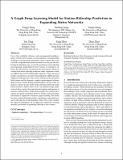A Graph Deep Learning Model for Station Ridership Prediction in Expanding Metro Networks
Author(s)
Ding, Fangyi; Liang, Yuebing; Wang, Yamin; Tang, Yan; Zhou, Yang; Zhao, Zhan; ... Show more Show less
Download3681780.3697247.pdf (1.227Mb)
Publisher Policy
Publisher Policy
Article is made available in accordance with the publisher's policy and may be subject to US copyright law. Please refer to the publisher's site for terms of use.
Terms of use
Metadata
Show full item recordAbstract
Due to their reliability, efficiency, and environmental friendliness, metro systems have become a crucial solution to transportation challenges associated with urbanization. Many countries have constructed or expanded their metro networks over the past decades. During the planning stage, accurately predicting station ridership post-expansion, particularly for new stations, is essential to enhance the effectiveness of infrastructure investments. However, station-level metro ridership prediction under expansion scenarios (MRP-E) has not been thoroughly explored, as most advanced models currently focus on short-term predictions. MRP-E presents significant challenges due to the absence of historical data for newly built stations and the dynamic, complex spatiotemporal relationships between stations during expansion phases. In this study, we propose a Metro-specific Multi-Graph Attention Network model (Metro-MGAT) to address these issues. Our model leverages multi-sourced urban context data and network topology information to generate station features. Multi-relation graphs are constructed to capture the spatial correlations between stations, and an attention mechanism is employed to facilitate graph encoding. The model has been evaluated through realistic experiments using multi-year metro ridership data from Shanghai, China. The results validate the superior performance of our approach compared to existing methods, particularly in predicting ridership at new stations.
Description
UrbanAI’24, October 29–November 01, 2024, Atlanta, GA
Date issued
2024-10-29Department
Singapore-MIT Alliance in Research and Technology (SMART)Publisher
ACM|2nd ACM SIGSPATIAL International Workshop on Advances in Urban-AI
Citation
Ding, Fangyi, Liang, Yuebing, Wang, Yamin, Tang, Yan, Zhou, Yang et al. 2024. "A Graph Deep Learning Model for Station Ridership Prediction in Expanding Metro Networks."
Version: Final published version
ISBN
979-8-4007-1156-5